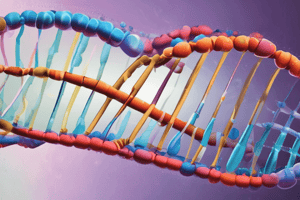Podcast
Questions and Answers
What is the error rate of E.coli during DNA replication?
What is the error rate of E.coli during DNA replication?
- 1 in a million nucleotides
- 1 in a thousand nucleotides
- 1 in 6400 nucleotides
- 1 in a billion nucleotides (correct)
How does the semi-conservative model of DNA replication work?
How does the semi-conservative model of DNA replication work?
- The DNA strands remain intact without being copied.
- Both strands of DNA are entirely new.
- Each new DNA molecule is made up of one parental and one new strand. (correct)
- Each parental strand is fragmented and reassembled.
What characteristic feature pertains to the structure of DNA?
What characteristic feature pertains to the structure of DNA?
- Two hydrogen bonds pair G with C
- Five base pairs per turn
- Right-handed double helix (correct)
- Left-handed double helix
What is the replication rate of E.coli in nucleotides per second?
What is the replication rate of E.coli in nucleotides per second?
Which of the following correctly describes the bonding between base pairs in DNA?
Which of the following correctly describes the bonding between base pairs in DNA?
What is the primary mechanism suggested by the Watson-Crick model for DNA replication?
What is the primary mechanism suggested by the Watson-Crick model for DNA replication?
What is the distance between stacked bases in a DNA double helix?
What is the distance between stacked bases in a DNA double helix?
Which aspect does NOT describe the E.coli's rapid DNA replication?
Which aspect does NOT describe the E.coli's rapid DNA replication?
Which of the following components is essential for DNA replication in prokaryotes?
Which of the following components is essential for DNA replication in prokaryotes?
Which component is necessary for providing the building blocks during DNA replication in prokaryotes?
Which component is necessary for providing the building blocks during DNA replication in prokaryotes?
Which of the following enzymes is specifically involved in DNA replication in prokaryotes?
Which of the following enzymes is specifically involved in DNA replication in prokaryotes?
What is a characteristic of the primers used in prokaryotic DNA replication?
What is a characteristic of the primers used in prokaryotic DNA replication?
Which of the following components is NOT required for DNA replication in prokaryotes?
Which of the following components is NOT required for DNA replication in prokaryotes?
Flashcards are hidden until you start studying
Study Notes
DNA Replication: A Review
- Central Dogma of Molecular Biology: Information flows from DNA to RNA to protein.
- DNA Replication: The process by which DNA is copied, ensuring that genetic information is passed on when cells divide.
- Accuracy of Replication: Errors are extremely rare, occurring less than once per billion nucleotides.
- Speed of Replication: In bacteria like E. coli, DNA replication occurs at a rate of 1,000 nucleotides per second.
- Review of DNA Structure:
- The DNA double helix is composed of two anti-parallel strands, running in opposite directions (5' to 3').
- Adenine pairs with thymine (A-T) via two hydrogen bonds.
- Guanine pairs with cytosine (G-C) via three hydrogen bonds.
- Semi-Conservative Replication: After one round of replication, each new DNA molecule is composed of one parental strand and one newly synthesized strand.
- Alternative Replication Models: Three models were proposed for DNA replication:
- Conservative model: The original parental DNA remains completely intact, and a new double helix is generated.
- Dispersive model: Both strands of the new DNA are a mixture of parental and newly synthesized DNA.
- Semi-conservative model: The correct model, where each new DNA molecule contains one original strand and one new strand.
- Importance of DNA Replication: This accurate and rapid process is essential for cell division, ensuring genetic stability and passing on genetic information to daughter cells.
DNA Replication in Prokaryotes
- DNA template is the original DNA strand that is being copied
- DNA Primers are short sequences of nucleotides that provide a starting point for DNA polymerase
- dNTPs (deoxyribonucleoside triphosphates) are the building blocks of DNA. They consist of a deoxyribose sugar, a phosphate group, and a nitrogenous base.
- RNA Primers are short RNA sequences that provide a starting point for DNA polymerase.
- DNA polymerase I is the enzyme that removes RNA primers and fills in the gaps with DNA nucleotides. It also has a 5' to 3' exonuclease activity, which it uses to remove RNA primers.
- Co2+ is a cofactor for some DNA polymerases. It is a mineral that is important for the proper functioning of DNA polymerase.
Studying That Suits You
Use AI to generate personalized quizzes and flashcards to suit your learning preferences.




